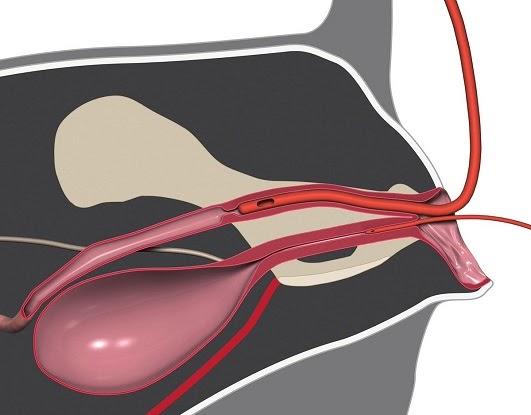How Do You Know to Go Back to Work After Hysterectomy

Whether y'all're having surgery, undergoing tests or have other medical needs involving your bladder, your doctor may demand to insert a catheter to assist in your diagnosis or treatment processes. A catheter is a device that'south inserted into your bladder to drain urine out of your body then information technology tin can then be nerveless for testing or disposed of. If you or a loved one demand to undergo catheterization, learning more than about what's involved, along with some other important information related to catheterization for women, can assist you experience more confident well-nigh and better prepared for the procedure.
Catheters are elementary devices; one of the well-nigh common, called a Foley catheter, consists of a hollow tube, a small balloon, a port and a drainage pocketbook. The pocket-sized airship is situated on one stop of the tube. This terminate is inserted upward through a patient's urethra — which is the small aqueduct that moves urine from the bladder to the outside of a person'south body — and into her bladder. The balloon is then inflated with sterile water, which holds the catheter tube in place and prevents leakage. The port section splits the inserted portion of the tube into two dissever tubes, one of which directs urine into the drainage pocketbook. The other tube section allows for inflation and deflation of the balloon.

A Foley catheter is a type of indwelling catheter. "Indwelling" means that the catheter remains inside the urethra and bladder for a brusque or long menstruum of time, such equally days or weeks, without removal. These types of catheters are mostly used for managing long-term health conditions, such as urinary incontinence or an inability to urinate. Doctors too typically use indwelling catheters for people who are bedridden or unconscious due to conditions like a coma or because they're nether general anesthesia.
Some other type of catheter insertion is called clean intermittent catheterization, or CIC. In this type of catheterization, the catheter doesn't remain in the bladder and urethra and it also doesn't have a balloon on the end. Instead, the catheter tube is inserted briefly — simply long enough for the patient's bladder to drain — and and then removed immediately. Medical professionals may perform CIC to obtain sterile urine samples from patients who have trouble urinating or to measure a person's urine output. Women who've had sure gynecologic surgeries may too opt to perform CIC on themselves if they're unable to empty their bladders following those procedures.
How Practise Doctors Insert Catheters?
The method of insertion for a catheter depends on the type of catheterization that you lot need. If you're having an indwelling catheter placed, during your appointment you'll remove clothing from the lower half of your trunk. You'll need to lie flat, bend your knees and spread your legs so the clinician tin access your urethra. They'll and then dissever your labia to clean your urethral opening and the expanse around it. Following this, the clinician will use a smoothen-tipped syringe to inject a small amount of lubricant into your urethra. This makes it easier for the catheter tubing to slide up to your bladder.

In one case this prepping is consummate, the clinician volition begin gently sliding the clean catheter upwards through your urethra until it reaches your bladder and urine begins flowing out. They'll inflate the balloon to hold the catheter in place and, if they haven't nonetheless, attach the drainage bag to the open terminate of the catheter tubing. Yous'll wear and empty this bag (or replacement bags) until you have the catheter removed. Most people who wear indwelling catheters secure the bags to their legs so gravity helps the urine reach and stay in the bag. If you lot're having the catheter inserted for surgery, the medico may wait until you're already under anesthesia to place the device.
The process for placing an intermittent catheter is similar to that for the indwelling catheter. A clinician cleans around your urethra and lubricates it before placing the catheter tubing. After this, they can collect a urine sample and remove the catheter tubing. People also self-catheterize using CIC if they're unable to void urine on their own or if they need to rail their urine output for medical reasons. The procedure and the position your body is in may exist somewhat different if you lot use CIC at domicile — some people sit down on the toilet and perform CIC to drain their urine — and your doctor tin show yous the proper technique to use in this situation.
Are In that location Whatever Risks With Catheterization?
Catheterization is a relatively elementary process — and ane that'south mutual — merely there are a few risks associated with having a catheter inserted. A urinary tract infection (UTI) is the about common trouble for people who have indwelling catheters, according to the U.Due south. National Library of Medicine. This can happen if the catheter isn't sterilized properly before insertion. If leaner remain on the catheter when information technology's placed into your bladder, this can introduce the leaner into your float, where they begin multiplying — resulting in infection.

Later on you've had an indwelling catheter placed, it'south important to be on the sentry for changes in your urine'southward smell, amount and appearance. With a UTI, you might notice that your urine smells bad or has a much stronger odor than usual. Your urine might also look cloudy or thick, and yous may notice blood in it. The amount of urine collecting in the drainage purse may lessen fifty-fifty when y'all're notwithstanding drinking fluids.
Other UTI signs and symptoms to look out for include a fever, pain in your abdomen or lower dorsum, chills, aches, belch leaking effectually your urethra where the tube comes out and general fatigue. If you observe any of these symptoms after your catheter insertion, call your doctor immediately. They can remove the catheter and give yous antibiotics to help clear upwards the infection.
Insertion of a catheter tin can as well cause damage to your urethra and to your bladder. Although it'south very rare, sometimes a catheter tube can puncture a person'south float wall. If you have any questions or concerns about using or maintaining your catheter — or if you lot're experiencing pain after having information technology placed — don't hesitate to call your doctor for assistance.
Resource Links:
https://medlineplus.gov/ency/article/003981.htm
https://www.hcd.com/urology/foley-catheter/
https://medlineplus.gov/ency/patientinstructions/000140.htm
https://www.med.uottawa.ca/procedures/ucath/
https://www.cdc.gov/hai/pdfs/uti/CA-UTI_tagged.pdf
https://medlineplus.gov/ency/commodity/000483.htm
https://world wide web.ncbi.nlm.nih.gov/pmc/manufactures/PMC2865895/
freemanthrealthen.blogspot.com
Source: https://www.symptomfind.com/health/catheterization-for-women?utm_content=params%3Ao%3D740013%26ad%3DdirN%26qo%3DserpIndex
0 Response to "How Do You Know to Go Back to Work After Hysterectomy"
Post a Comment